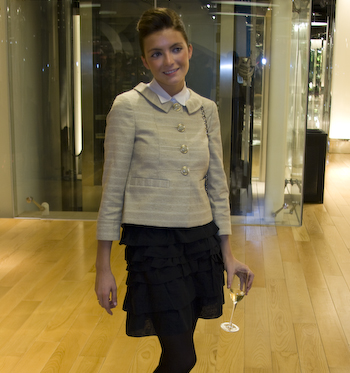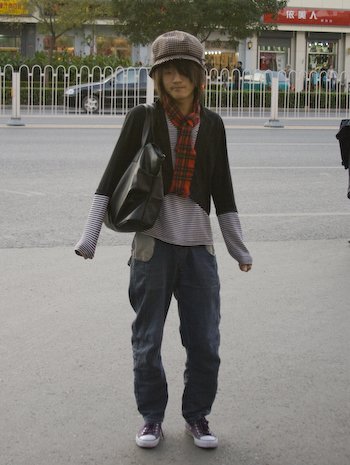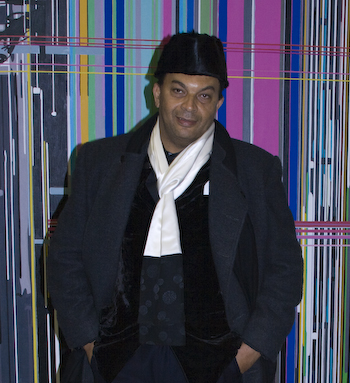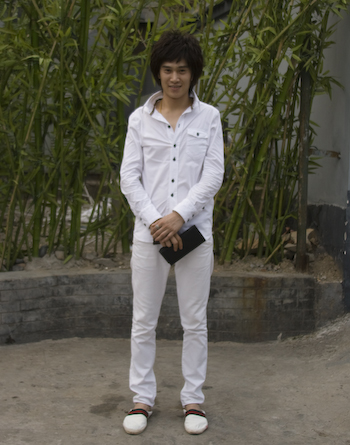
What could be more appropriate accessories for a hutong dweller than a bottle of Yanjing and a stray cat? A repeat cat rescuer, Mr. Gao is an oil painter living on a hutong running east from Nanluoguxiang.
I was rushing to a reception at 798 given by a foreign fashion designer when I encountered Mr. Gao. My goal was to photograph for Stylites, but I suggested he accompany me. The booze was sure to be flowing and he seemed already to be enjoying an afternoon of drinking. Since I had no invitation, it seemed an artist would get in and enjoy a night n refined society or, at least, society that does its utmost to appear refined. This assumption belies any appearance I may give of understanding social life in China, the fashion world, or life in general.
Mr. Gao dropped the cat at his house and we set off. Troubles began even before we made it to the taxi. Mr. Gao insisted on more beer for the two of us to enjoy on the road to 798. I wasn’t one to oppose a “walker” over which the two of us could bond during the long ride. Sadly, the instant after the shopkeeper produced our new beers, Mr. Gao accidently slammed the bottle he already had on the glass top of the freezer containing popsicles. The glass cracked. The customers and owner fixed their glance on the oddball whose own glasses happened already to be cracked.
The owner said all the goods in the freezer would melt and that he must pay compensation at once. The two or three humble patrons of the shop instantly appeared aggressive. One middle-aged woman announced that we must pay. When Mr. Gao said that he didn’t have enough money and that he was rushing to 798, the woman said that his foreign friend, meaning me, would have to pay. I pretended not to understand. Mr. Gao frantically repeated that we were on our way to an important event at 798 and that we couldn’t be late. The shopkeeper demanded money. Muttering about 798, Mr. Gao handed over his one hundred yuan note. We hastily exited the shop with yells and snarls following us. Feeling guilty for not paying, I felt angry gazes on my back.
Villains, we jumped into a cab before we could see whether the angry woman and shopkeeper were after us. Mr. Gao was protesting that we should take the bus, but I assured him I would pay for the cab. After a long ride of strained conversation in which I determined that he was around 40 and lived his parents, we arrived at the factory where the fashion event was being held. We entered, me trying to appear confident as possible, while worrying that Mr. Gao might present some kind of difficulty. I was there to take pictures, but quickly I realized that I would have to give my guest full-time care in an environment where he was such a fish out of water.
I snatched a glass of champagne at once, hoping this would be all my new friend needed to calm his spirit. The place was filled with the usual crowd of poseurs. As usual, my duty was to find the ones who were truly special, the ones that had a certain grace and substance. I always look for the people whose style or eyes suggest there may be something more profound, a good story, or, at the very least, creative affectations. China is complicated and dense. Despite this or perhaps as a result of it, even after all of these years, I still fail to unearth the gems.
Several people’s outfits were worthy of the mighty Stylites. Before I could photograph more than three, a security guard was tapping on my back. Mr. Gao was arguing with him. The guests at the event felt unsafe with such a vagrant like this around. Though the event was so casual that not a single person was in a suit, I felt like a real fool for having dragged the old boy into such an unsuitable situation. The guilt was mainly toward the artist himself. I have no idea if his art is worth anything, but it seemed wrong that I had caused harm to someone who had been rescuing stray cats an hour before. The guard said there was no way he could stay – no matter how famous of an artist he was. We rushed away from Beijing’s fashionable set and headed back toward the old city. I wondered whether I should regret my careless taste for spontaneity and misadventure. The night had not been a success in terms of photos for Stylites.


















